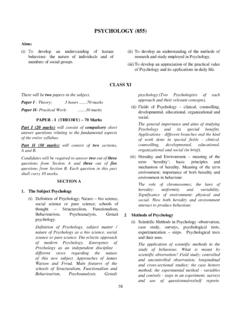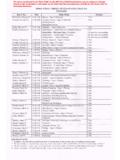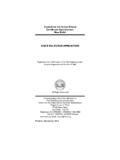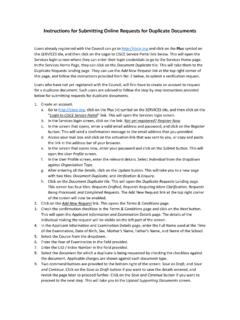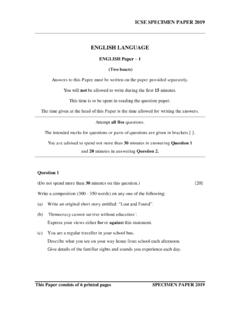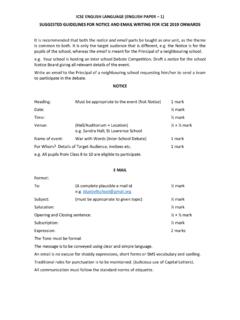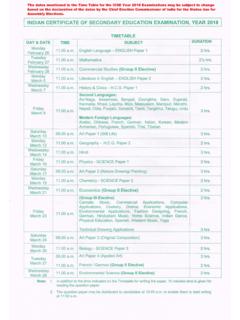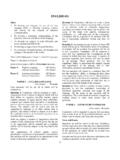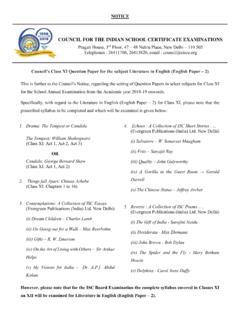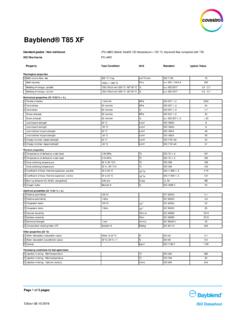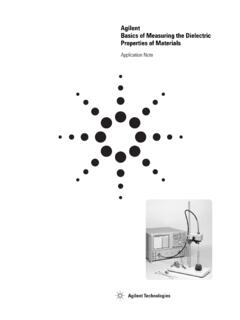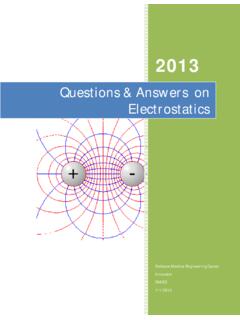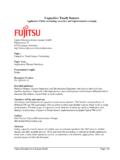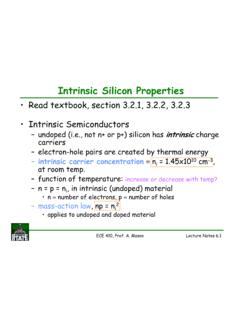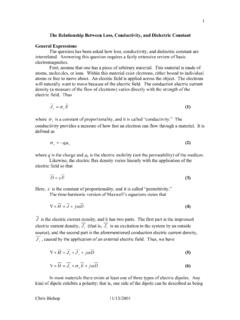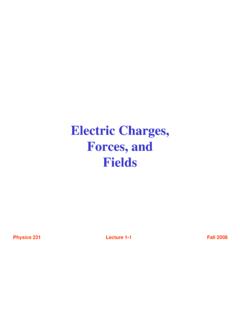Transcription of PHYSICS (861)
1 PHYSICS (861). CLASS XII. There will be two papers in the subject: Paper I: Theory - 3 hours .. 70 marks Paper II: Practical - 3 hours .. 15 marks Project Work .. 10 marks Practical File .. 5 marks PAPER I- THEORY: 70 Marks There will be no overall choice in the paper. Candidates will be required to answer all questions. Internal choice will be available in two questions of 2 marks each, two questions of 3 marks each and all the three questions of 5 marks each. S. NO. UNIT TOTAL WEIGHTAGE. 1. Electrostatics 14 Marks 2. Current Electricity 3. Magnetic Effects of Current and Magnetism 16 Marks 4. Electromagnetic Induction and Alternating Currents 5. Electromagnetic Waves 6. Optics 20 Marks 7. Dual Nature of Radiation and Matter 13 Marks 8. Atoms and Nuclei 9. Electronic Devices 7 Marks TOTAL 70 Marks 1.. PAPER I -THEORY- 70 Marks electric field E experiences an electric . Note: (i) Unless otherwise specified, only S. I. force FE = qE . Intensity due to a Units are to be used while teaching and learning, continuous distribution of charge as well as for answering questions.
2 Linear, surface and volume. (ii) All physical quantities to be defined as and (c) Electric lines of force: A convenient when they are introduced along with their units and way to visualize the electric field;. dimensions. properties of lines of force; examples (iii) Numerical problems are included from all of the lines of force due to (i) an topics except where they are specifically excluded isolated point charge (+ve and - ve);. or where only qualitative treatment is required. (ii) dipole, (iii) two similar charges at a small distance;(iv) uniform field 1. Electrostatics between two oppositely charged parallel plates. (i) Electric Charges and Fields (d) Electric dipole and dipole moment;. Electric charges; conservation and . derivation of the E at a point, (1) on quantisation of charge, Coulomb's law; the axis (end on position) (2) on the superposition principle and continuous perpendicular bisector (equatorial charge distribution. broad side on position) of a dipole, Electric field, electric field due to a point also for r>> 2l (short dipole); dipole in charge, electric field lines, electric dipole, a uniform electric field; net force zero, electric field due to a dipole, torque on a torque on an electric dipole: dipole in uniform electric field.
3 = p E and its derivation. Electric flux, Gauss's theorem in Electrostatics and its applications to find (e) Gauss' theorem: the flux of a vector . field due to infinitely long straight wire, field; Q=vA for velocity vector v A, uniformly charged infinite plane sheet.. (a) Coulomb's law, unit of A is area vector. Similarly, for electric . charge; permittivity of free space field E , electric flux E = EA for E A. and of dielectric medium.. Frictional electricity, electric charges and E= E A for uniform E . For . (two types); repulsion and non-uniform field E = d = . attraction; simple atomic structure - Special cases for = 00, 900 and 1800. electrons and ions; conductors Gauss' theorem, statement: E =q/ 0. and insulators; quantization and q conservation of electric charge; or E = dA = 0 where E is for E. Coulomb's law in vector form;. (position coordinates r 1 , r 2 not a closed surface; q is the net charge necessary). Comparison with Newton's enclosed, o is the permittivity of free law of gravitation; space.
4 Essential properties of a Superposition principle Gaussian surface.. ( F= 1 ). F 12 + F 13 + F 14 + . Applications: Obtain expression for E.. due to (1) an infinite line of charge, (2). (b) Concept of electric field and its a uniformly charged infinite plane thin intensity; examples of different fields; sheet. gravitational, electric and magnetic;. Electric field due to a point charge (ii) Electrostatic Potential, Potential Energy and Capacitance E = F / qo (q 0 is a test charge); E for a group of charges (superposition Electric potential, potential difference, principle); a point charge q in an electric potential due to a point charge, a dipole and system of charges;. 2. equipotential surfaces, electrical potential 1 2 1 1 Q2. energy of a system of two point charges CV = QV = ) and energy and of electric dipole in an electrostatic 2 2 2 C. field. density. Conductors and insulators, free charges (c) Dielectric constant K = C'/C; this is also and bound charges inside a conductor.
5 Called relative permittivity K = r =. Dielectrics and electric polarisation, / o; elementary ideas of polarization of capacitors and capacitance, combination matter in a uniform electric field of capacitors in series and in parallel. qualitative discussion; induced surface Capacitance of a parallel plate capacitor, charges weaken the original field; results . energy stored in a capacitor. in reduction in E and hence, in pd, (V);. (a) Concept of potential, potential for charge remaining the same Q = CV. difference and potential energy. = C' V' = K. CV'; V' = V/K;. Equipotential surface and its and E = E ; if the Capacitor is kept properties. Obtain an expression for K. electric potential at a point due to a connected with the source of emf, V is point charge; graphical variation of E kept constant V = Q/C = Q'/C' ; Q'=C'V. and V vs r, VP=W/q0; hence VA -VB = = K. CV= K. Q. WBA/ q0 (taking q0 from B to A) = increases; For a parallel plate capacitor (q/4 0)(1/rA - 1/rB); derive this with a dielectric in between, equation; also VA = q/4 0.
6 1/rA ; for C' = KC = K. o . A/d = r . o .A/d. q>0, VA>0 and for q<0, VA < 0. For a 0 A. Then C = ; for a capacitor collection of charges V = algebraic d . sum of the potentials due to each . r . charge; potential due to a dipole on its partially filled dielectric, capacitance, axial line and equatorial line; also at C' = oA/(d-t + t/ r). any point for r>>2l (short dipole). Potential energy of a point charge (q) 2. Current Electricity . in an electric field E , placed at a point Mechanism of flow of current in conductors. P where potential is V, is given by U. Mobility, drift velocity and its relation with =qV and U =q (VA-VB) . The electric current; Ohm's law and its proof, electrostatic potential energy of a resistance and resistivity and their relation to system of two charges = work done drift velocity of electrons; V-I characteristics W21=W12 in assembling the system; U12 (linear and non-linear), electrical energy and or U21 = (1/4 0 ) q1q2/r12. For a power, electrical resistivity and system of 3 charges U123 = U12 + U13 + conductivity.
7 Temperature dependence of 1 q1 q 2 q1 q3 q 2 q3 resistance and resistivity. U23 = ( + ). +. 4 0 r12 r13 r23 Internal resistance of a cell, potential For a dipole in a uniform electric field, difference and emf of a cell, combination of derive an expression of the electric cells in series and in parallel, Kirchhoff's laws and simple applications, Wheatstone bridge, potential energy UE = - p . E , special metre bridge. Potentiometer - principle and its cases for =00, 900 and 1800. applications to measure potential difference, (b) Capacitance of a conductor C = Q/V; to compare emf of two cells; to measure obtain the capacitance of a parallel- internal resistance of a cell. plate capacitor (C = 0A/d) and (a) Free electron theory of conduction;. equivalent capacitance for capacitors in acceleration of free electrons, relaxation series and parallel combinations. Obtain time ; electric current I = Q/t; concept of an expression for energy stored (U = drift velocity and electron mobility.)
8 Ohm's law, current density J = I/A; experimental 3. verification, graphs and slope, ohmic V=+ and going from +ve to -ve terminal and non-ohmic conductors; obtain the through the cell, we are going down, so V. relation I=vdenA. Derive = ne2 /m and = - . Application to simple circuits. = m/ne2 ; effect of temperature on Wheatstone bridge; right in the beginning resistivity and resistance of conductors take Ig=0 as we consider a balanced and semiconductors and graphs. bridge, derivation of R1/R2 = R3/R4. Resistance R= V/I; resistivity , given by R [Kirchhoff's law not necessary]. Metre = .l/A; conductivity and conductance; bridge is a modified form of Wheatstone bridge, its use to measure unknown Ohm's law as J = E . resistance. Here R3 = l1 and R4=l2 ;. (b) Electrical energy consumed in time R3/R4=l1/l2. Principle of Potentiometer: fall t is E=Pt= VIt; using Ohm's law in potential V l; auxiliary emf 1 is E= V ( R ) t = I Rt. Potential difference 2. 2 balanced against the fall in potential V1.
9 Across length l1. 1 = V1 =Kl1 ; 1/ 2 = l1/l2;. V = P/ I; P = V I; Electric power consumed potentiometer as a voltmeter. Potential P = VI = V2 /R = I2 R; commercial units; gradient and sensitivity of potentiometer. electricity consumption and billing. Use of potentiometer: to compare emfs of (c) The source of energy of a seat of emf (such two cells, to determine internal resistance as a cell) may be electrical, mechanical, of a cell. thermal or radiant energy. The emf of a 3. Magnetic Effects of Current and Magnetism source is defined as the work done per unit charge to force them to go to the higher (i) Moving charges and magnetism point of potential (from -ve terminal to +ve Concept of magnetic field, Oersted's terminal inside the cell) so, = dW /dq; but experiment. Biot - Savart law and its dq = Idt; dW = dq = Idt . Equating total application. Ampere's Circuital law and its work done to the work done across the applications to infinitely long straight wire, external resistor R plus the work done straight and toroidal solenoids (only across the internal resistance r; Idt=I2R dt qualitative treatment).
10 Force on a moving + I2rdt; =I (R + r); I= /( R + r ); also charge in uniform magnetic and electric IR +Ir = or V= - Ir where Ir is called the fields. Force on a current-carrying back emf as it acts against the emf ; V is conductor in a uniform magnetic field, the terminal pd. Derivation of formulae for force between two parallel current- combination for identical cells in series, carrying conductors-definition of ampere, parallel and mixed grouping. Parallel torque experienced by a current loop in combination of two cells of unequal emf. uniform magnetic field; moving coil Series combination of n cells of unequal galvanometer - its sensitivity. Conversion emf. of galvanometer into an ammeter and a voltmeter. (d) Statement and explanation of Kirchhoff's laws with simple examples. The first is a (ii) Magnetism and Matter conservation law for charge and the 2nd is A current loop as a magnetic dipole, its law of conservation of energy. Note change magnetic dipole moment, magnetic dipole in potential across a resistor V=IR<0 moment of a revolving electron.
